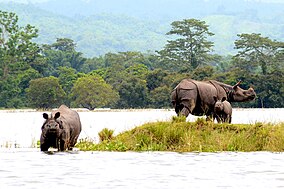Kaziranga National Park: National park in the state of Assam, India
Kaziranga National Park is a national park in India.
The park is home to two-thirds of the world's great one-horned rhinoceroses. It is a World Heritage Site. It was named a Tiger Reserve by the government of India and an Important Bird Area by BirdLife International.
| Kaziranga National Park | |
|---|---|
| Kaziranga Rashtriya Udyaan | |
IUCN category II (national park) | |
 Adult Indian rhinoceros with a calf at Kaziranga National Park | |
| Location | Golaghat and Nagaon, Assam |
| Nearest city | Golaghat, Nagaon |
| Coordinates | 26°40′N 93°21′E / 26.667°N 93.350°E |
| Area | 430 km2 (170 sq mi) |
| Established | 1908 |
| Governing body | Government of India, Government of Assam |
| World Heritage site | World Heritage Place by UNESCO since 1985 |
Kaziranga is home to large breeding populations of tigers, elephants, wild water buffalo, and swamp deer. One type of swamp deer now only exists in the park.
History
The Kaziranga Proposed Reserve Forest was created in 1905. Mary Curzon, the wife of the Viceroy of India, wanted the area protected mostly to save the rhinoceros. In 1908, Kaziranga was designated a "Reserve Forest". In 1916 it was renamed "Kaziranga Game Sanctuary" then changed to “Wild Life Sanctuary” in 1950.
Geography
The park is located in both the Nagaon district and Golaghat district, in the state of Assam in India. It is about 40 kilometres (25 mi) long and 13 kilometres (8 mi) wide.
The park is crossed by four main rivers — Brahmaputra, Diphlu, Mora Diphlu and Mora Dhansiri. There are also many small water bodies.
The park is within the Brahmaputra floodplain. This means when the water in the river rises, the park is partially covered in water. Flooding happens every year which results in over half the park being underwater. In 2017, 85% of the park was underwater. At least 107 animals died because of the flooding in 2017. There are elevated areas of the park which provide retreats and shelter for animals during floods. These are called chapories. Many artificial chapories have been built with the help of the Indian Army to ensure the safety of the animals.
Climate
The park has three seasons: winter, summer, and monsoon. The winter season is between November and February. It is mild and dry. The small water bodies dry up and short grass covers the bed. The summer season between March and May is hot. The animals can be found near water during these months. The rainy monsoon season lasts from June to September.
Fauna


Kaziranga National Park is home to 35 major mammals. This includes 15 mammals under the highest protection in India. The One-Horned rhinoceros, Royal Bengal Tiger, Asian elephant, wild water buffalo and swamp deer are collectively known as the 'Big Five' of Kaziranga. In addition there are gaur, sloth bears, clouded leopards, wild boar, and several deer species. Small mammals include the rare hispid hare, mongoose, civet, pangolin, and badgers. The park also is home to several primates. These include macaques, lutungs, the Bengal slow loris, and the only ape in India - the hoolock gibbon. Kaziranga's rivers are home to the endangered Ganges dolphin.
More than 490 bird species live in Kaziranga which includes 24 globally threatened species. The park is known for its nesting colonies of Spot-billed Pelicans and Adjutants. Waterfowl which breed in or pass through Kaziranga include several rare species of geese (lesser white-fronted goose), and ducks (ferruginous pochard, Baer's pochard). Other rare riverine birds include kingfishers, herons, shanks, and terns. Raptors include the rare eastern imperial eagle, other eagles, and the lesser kestrel.
Two of the largest snakes in the world, the reticulated python and the rock python, are common inside the park. It is also home to the king cobra, Indian cobra, Russell's viper, and common krait. Fifteen species of turtle live in Kaziranga. 42 species of fishes are found in the Kaziranga area, including the unusual ocellated pufferfish.
Flora
There are four main types of plant life in Kaziranga National Park. These are alluvial inundated grasslands, alluvial savanna woodlands, tropical moist mixed deciduous forests, and tropical semi-evergreen forests. Percent coverage by vegetation is: tall grasses 41%, short grasses 11%, open jungle 29%, swamps 4%, rivers and water bodies 8%, and sand 6%.
References
Other websites
- Official website of Kaziranga Archived 2022-06-19 at the Wayback Machine
This article uses material from the Wikipedia Simple English article Kaziranga National Park, which is released under the Creative Commons Attribution-ShareAlike 3.0 license ("CC BY-SA 3.0"); additional terms may apply (view authors). Content is available under CC BY-SA 4.0 unless otherwise noted. Images, videos and audio are available under their respective licenses.
®Wikipedia is a registered trademark of the Wiki Foundation, Inc. Wiki Simple English (DUHOCTRUNGQUOC.VN) is an independent company and has no affiliation with Wiki Foundation.